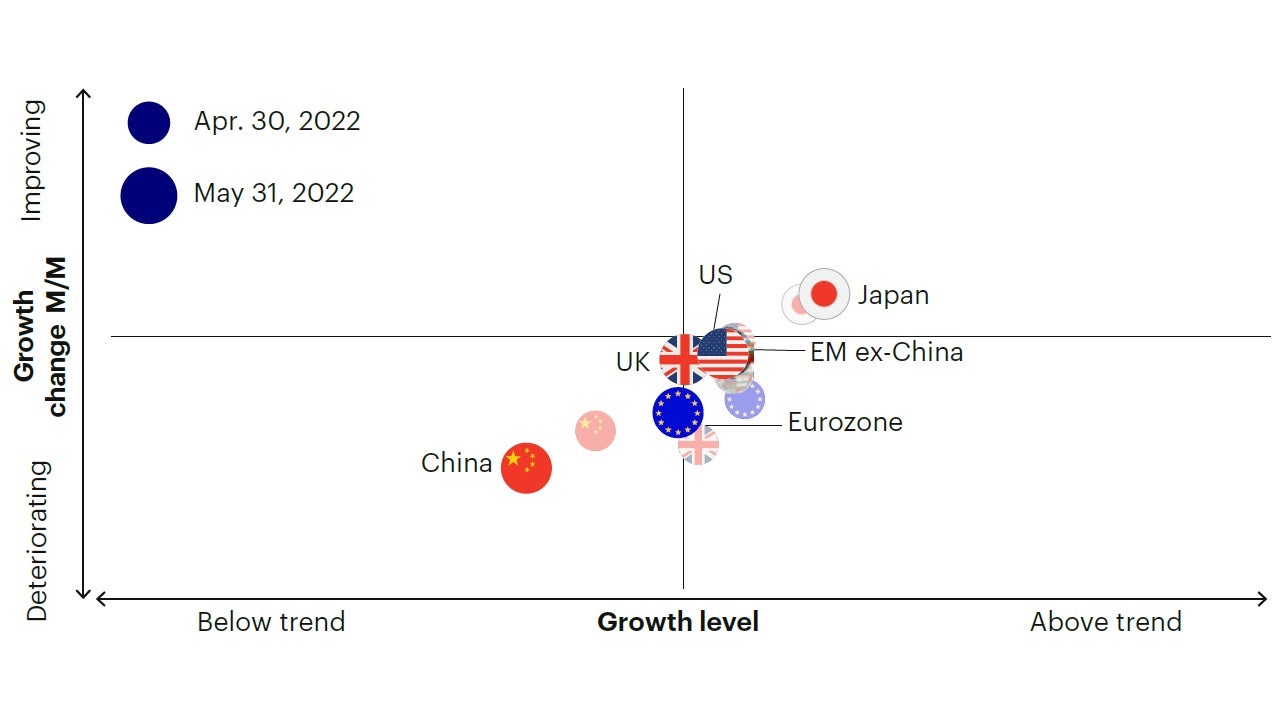Tactical Asset Allocation: June 2022

We remain overweight risk relative to benchmark, favoring equities over fixed income with an emphasis on emerging markets, cyclicals, and value. We moderately increased credit risk given wider spreads.
Synopsis
- Global equity markets have underperformed since we increased portfolio risk in early April, and leading economic indicators have deteriorated further. However, our market-based sentiment framework shows more stability and still points toward positive growth revisions ahead.
- We are overweight risk relative to benchmark in the Global Tactical Asset Allocation model1, favoring equities over fixed income with an emphasis on emerging markets, cyclical sectors, value, and small/mid-caps. We have moderately increased credit risk and stay underweight duration.
Macro update
Our leading economic indicators declined sharply for the second consecutive month, reflecting the impact of the war in Ukraine, China’s zero-COVID policy, and higher cost of capital. Unsurprisingly, the decline in economic activity has been most pronounced in China, the Eurozone, and the United Kingdom which, based on our indicators, are now likely to grow below trend over the next few quarters. Despite the resilience in other large economies (US and Japan), the global economic picture has weakened substantially, and our Global LEI is fast declining toward its long-term average, i.e., our proxy for trend growth (Figure 1 and Figure 2).

Despite the resilience in other large economies (US and Japan), the global economic picture has weakened substantially.

Sources: Bloomberg L.P., Macrobond. Invesco Investment Solutions research and calculations. Proprietary leading economic indicators of Invesco Investment Solutions. Macro regime data as of May. 31, 2022. The Leading Economic Indicators (LEIs) are proprietary, forward-looking measures of the level of economic growth. The Global Risk Appetite Cycle Indicator (GRACI) is a proprietary measure of the markets’ risk sentiment.
Business surveys across manufacturing and service sectors have declined from the peak, but they continue to show resilience and still suggest above-trend business prospects.
Figure 2: Global risk appetite is accelerating, signaling improving growth expectations
GRACI and the global LEI

Sources: Bloomberg L.P., MSCI, FTSE, Barclays, JPMorgan, Invesco Investment Solutions research and calculations, from Jan. 1, 1992 to May 31, 2022. The Global Leading Economic Indicator (LEI) is a proprietary, forward-looking measure of the growth level in the economy. A reading above (below) 100 on the Global LEI signals growth above (below) a long-term average. The Global Risk Appetite Cycle Indicator (GRACI) is a proprietary measure of the markets’ risk sentiment. A reading above (below) zero signals a positive (negative) compensation for risk taking in global capital markets in the recent past. Past performance does not guarantee future results.
In terms of economic sectors, consumer confidence surveys across countries have already declined to the recessionary lows experienced in 2008. However, strong labor market conditions today provide a very different backdrop of consumer resilience relative to other recessionary episodes. Business surveys across manufacturing and service sectors have declined from the peak, but they continue to show resilience and still suggest above-trend business prospects. China is the noticeable but not surprising exception. New COVID-related lockdowns since April have caused a meaningful decline in industrial production, construction activity and retail spending, which have led the People’s Bank of China to release a broad range of stimulative tools. However, stimulus efforts may have limited effect if mobility restrictions remain in place.
While equity and fixed income markets have continued to post negative returns since then, our framework still suggests this underperformance is predominantly driven by higher discount yields rather than deteriorating earnings expectations.
At the end of Q1 our macro regime framework moved back into an expansionary regime, led by an improvement in global market sentiment and above average economic activity. While equity and fixed income markets have continued to post negative returns since then, our framework still suggests this underperformance is predominantly driven by higher discount yields rather than deteriorating earnings expectations. The recent outperformance of cyclical market segments such as value equities, small/mid-caps, and emerging markets relative to more defensive segments such as growth, large-cap and US equities provides some support to this hypothesis. In other words, more than an “inflation scare” turning into a “growth scare,” we believe markets have moved from an inflation scare to a de-rating of valuations, particularly in high-duration US growth stocks. Nonetheless, economic risks are rising and a stabilization in credit spreads would be required to prevent further declines in equity markets.
Inflation remains the primary driver of markets. Downside surprises in inflation statistics may represent the most powerful catalyst for a rebound in markets, alleviating risks of excessively restrictive monetary policy. We continue to register accelerating inflation in the near term, but at a somewhat lower pace than the past few months (Figure 3). Interestingly, the rollover in US breakeven inflation expectations seems to suggest a likely peak in actual inflation in the near term2.
Downside surprises in inflation statistics may represent the most powerful catalyst for a rebound in markets, alleviating risks of excessively restrictive monetary policy.

Sources: Bloomberg L.P. data as of May 31, 2022, Invesco Investment Solutions calculations. The US Inflation Momentum Indicator (IMI) measures the change in inflation statistics on a trailing three-month basis, covering indicators across consumer and producer prices, inflation expectation surveys, import prices, wages, and energy prices. A positive (negative) reading indicates inflation has been rising (falling) on average over the past three months.
Investment positioning
We maintain an overweight risk stance relative to benchmark in the Global Tactical Asset Allocation model1, overweighting equities relative to fixed income, favoring emerging markets over developed markets, and tilting toward cyclical sectors and factors. We moderately increased credit risk3, shifting from short to intermediate credit maturities, and remain underweight duration risk in aggregate while maintaining a flattening yield curve bias. (Figure 4, 5, 6). In particular:
- Within equities we overweight cyclical factors like (small) size, value, and momentum, and favor cyclical sectors such as financials, industrials, materials, and energy at the expense of information technology, communication services, and other defensive sectors (Figure 6). We expect cyclicals to continue outperforming in an environment of rising bond yields and improving risk appetite. From a regional perspective, we overweight emerging markets relative to developed markets as stable risk appetite and attractive valuations tend to benefit the asset class.
- In fixed income we have reduced the overweight in inflation-linked bonds relative to nominal Treasuries given the recent softening in inflation momentum (Figure 3). We maintain an underweight duration stance in aggregate, with a bias toward a flatter curve. We added some credit exposure by increasing spread duration in high yield, looking for some spread compression after the widening of the past few months.
- In currency markets we remain underweight the US dollar, a position driven by expensive valuations and positive economic surprises in the Eurozone and emerging markets relative to consensus expectations. Within developed markets we favor the euro, Japanese yen, Canadian dollar, Singapore dollar, Norwegian kroner, and Swedish krona. In EM we favor high yielders with attractive valuations such as the Indonesian rupiah, Colombian peso, and Brazilian real. We underweight the British pound, Swiss franc, Australian dollar, and Korean won.
Figure 4: Relative tactical asset allocation positioning
Portfolio risk above benchmark, overweight EM and cyclicals. Reduced overweight in TIPS versus nominal bonds.

Source: Invesco Investment Solutions, May 31, 2022. DM = developed markets. EM = emerging markets. FX = foreign exchange. For illustrative purposes only.
Figure 5: Tactical factor positioning
Factor tilts within the expansion regime are toward size, value and momentum

Source: Invesco Investment Solutions, May 31, 2022. For illustrative purposes only. Neutral refers to an equally weighted factor portfolio.
Figure 6: Tactical sector positioning
In an expansionary regime, sector tilts favor cyclicals relative to defensives.

Source: Invesco Investment Solutions, May 31, 2022. For illustrative purposes only. Sector allocations derived from factor and style allocations based on proprietary sector classification methodology. As of March 2022, Cyclicals: energy, financials, industrials, materials; Defensives: consumer staples, health care, information technology, real estate, communication services, utilities; Neutral: consumer discretionary.
Footnotes
-
1
Global 60/40 benchmark (60% MSCI ACWI / 40% Bloomberg Barclays Global Agg USD hedged)
-
2
US breakeven inflation expectations have declined by 100bps, 70bps and 50bps from the peak in 2-year, 5-year and 10-year maturities, respectively.
-
3
Credit risk defined as duration times spread (DTS).
当資料ご利用上のご注意
当資料は情報提供を目的として、インベスコ・アセット・マネジメント株式会社(以下、「当社」)のグループに属する運用プロフェッショナルが英文で作成したものであり、法令に基づく開示書類でも金融商品取引契約の締結の勧誘資料でもありません。内容には正確を期していますが、必ずしも完全性を当社が保証するものではありません。また、当資料は信頼できる情報に基づいて作成されたものですが、その情報の確実性あるいは完結性を表明するものではありません。当資料に記載されている内容は既に変更されている場合があり、また、予告なく変更される場合があります。当資料には将来の市場の見通し等に関する記述が含まれている場合がありますが、それらは資料作成時における作成者の見解であり、将来の動向や成果を保証するものではありません。また、当資料に示す見解は、インベスコの他の運用チームの見解と異なる場合があります。過去のパフォーマンスや動向は将来の収益や成果を保証するものではありません。当社の事前の承認なく、当資料の一部または全部を使用、複製、転用、配布等することを禁じます。
20220614-2241881-JP
そのほかの投資関連情報はこちらをご覧ください。https://www.invesco.com/jp/ja/institutional/insights.html

